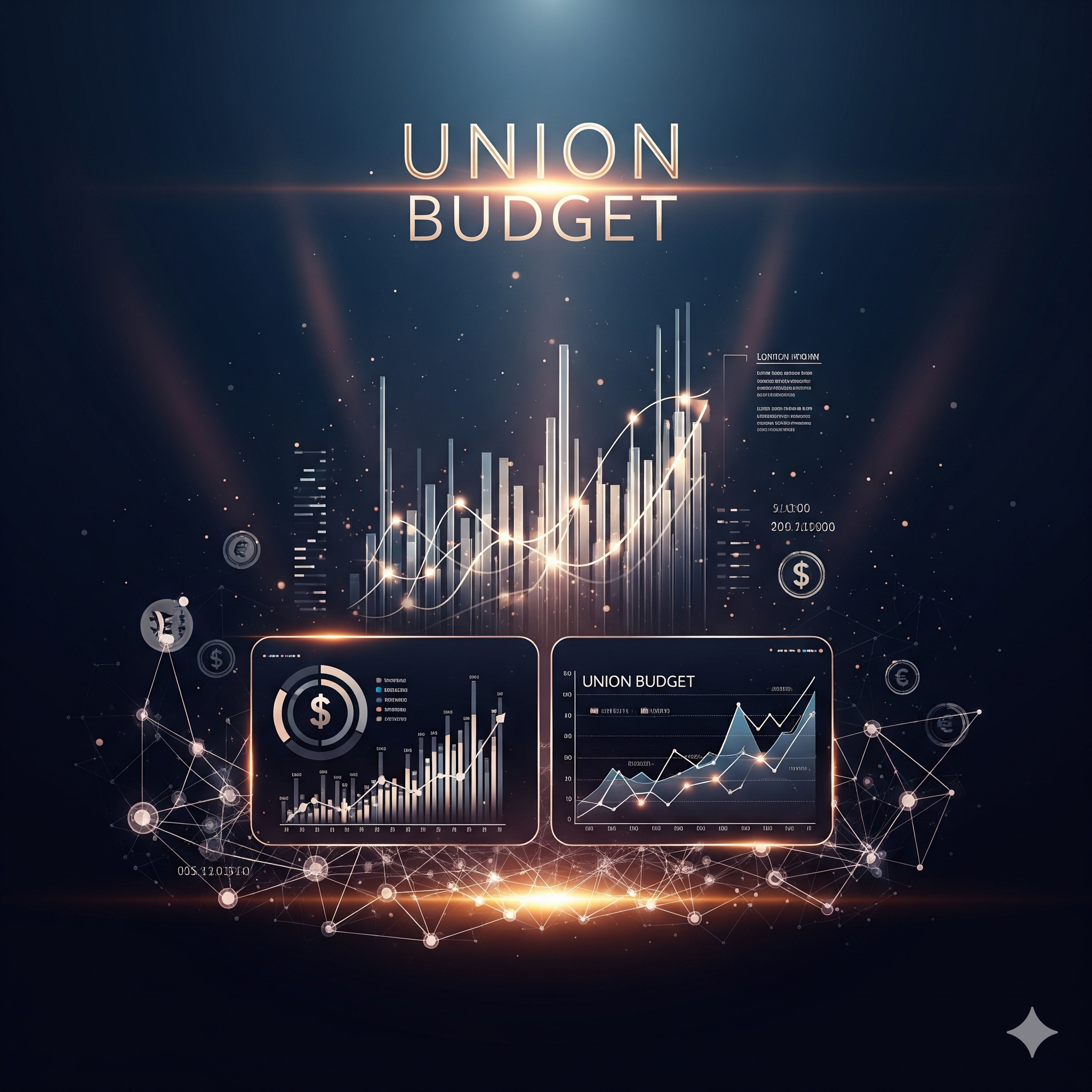Introduction
The Union Budget is one of the most important annual events in India’s governance and economic management. Often described as the annual financial statement of the central government, the Union Budget reflects the priorities, strategies, and fiscal health of the nation. It is not just a financial document but also a political and economic statement, highlighting how the government plans to mobilize resources and allocate them across different sectors of the economy.
In simple terms, the Union Budget is a roadmap of how the government intends to raise money through taxes and other sources and how it plans to spend this money on various developmental and administrative activities. The Budget affects every citizen, as it directly influences taxation, subsidies, welfare schemes, and overall economic conditions such as inflation, growth, and employment.
This article explains the meaning of the Union Budget, its historical background, the preparation process, the stages of its enactment in Parliament, and the different types of budgeting practiced in India and globally.
What is the Union Budget?
The Union Budget of India, referred to in Article 112 of the Indian Constitution, is the Annual Financial Statement of the government. It provides a detailed account of the government’s estimated receipts (income) and expenditures (spending) for the upcoming financial year, which runs from 1st April to 31st March.
The Union Budget has two major parts:
- Revenue Budget – which includes the government’s revenue receipts (tax and non-tax income) and revenue expenditure (subsidies, defense pensions, administration, etc.).
- Capital Budget – which includes capital receipts (borrowings, recovery of loans, disinvestment) and capital expenditure (infrastructure, investment in public enterprises, loans to states, etc.).
The Budget is presented by the Finance Minister of India on the floor of the Lok Sabha, usually on the 1st of February each year. This practice ensures that the budgetary process is completed before the new financial year begins.
Historical Preview of the Union Budget
The history of the Indian Budget dates back to the colonial era when the British introduced structured financial management in India.
1. The First Indian Budget (1860)
- The very first budget in India was presented on 7th April 1860 by James Wilson, the Finance Member of the Council of India under the British Government.
- It primarily aimed at managing revenues from land and imports, particularly after the financial strain caused by the Revolt of 1857.
2. Post-Independence Budgets
- After independence, the first budget of free India was presented on 26th November 1947 by R.K. Shanmukham Chetty, the first Finance Minister of India.
- This budget covered only seven and a half months (August 15, 1947, to March 31, 1948).
3. Development-Oriented Budgets
- In the 1950s and 1960s, the budgets were heavily influenced by the Five-Year Plans, focusing on economic development, industrialization, and agriculture.
4. Tax and Subsidy Era
- From the 1970s to the early 1990s, Indian budgets emphasized high taxation, subsidies, and protectionist policies.
- This period saw high fiscal deficits and inefficiencies in the economy.
5. Economic Reforms and Liberalization
- The landmark budget of 1991, presented by Dr. Manmohan Singh, marked the beginning of economic liberalization.
- It reduced import duties, rationalized taxes, introduced disinvestment, and opened up the Indian economy to global markets.
6. Modern-Day Budgets
- Today, budgets focus on fiscal consolidation, infrastructure development, digital economy, welfare schemes, and inclusive growth.
- The practice of presenting a separate Railway Budget (introduced in 1924) was merged into the Union Budget in 2017.
- The date of budget presentation was advanced from the last working day of February to 1st February starting 2017 to allow early implementation.
Thus, the evolution of the Union Budget reflects the changing priorities of the Indian economy—from survival and consolidation in the early years, to growth and self-reliance in the mid-phase, and globalization and sustainability in recent times.
Preparation of the Union Budget
The preparation of the Union Budget is a complex and time-bound process involving several ministries, departments, and consultations. It generally begins in August–September of the preceding year and goes on till January.
Step 1: Estimates by Ministries and Departments
- Each ministry and department prepares estimates of its expected expenditure for the upcoming year.
- These demands are then submitted to the Ministry of Finance (Budget Division) for examination.
Step 2: Revenue Estimation
- The Department of Revenue estimates the likely revenue collection from taxes such as income tax, corporate tax, customs, and GST.
- Non-tax revenues like dividends, interest receipts, and profits from public sector enterprises are also estimated.
Step 3: Consultation with Stakeholders
- The Finance Ministry consults with various stakeholders including industry associations, trade bodies, economists, and experts.
- These consultations help in shaping tax policies and identifying areas for government support.
Step 4: Discussions with RBI and NITI Aayog
- The government consults the Reserve Bank of India (RBI) on monetary and fiscal coordination.
- The NITI Aayog provides inputs on development priorities and targets.
Step 5: Pre-Budget Meetings
- Pre-budget meetings are held with representatives from agriculture, industry, and social sectors to understand their needs and demands.
Step 6: Preparation of Budget Document
- The Finance Ministry consolidates all information into the Budget Document which includes:
- Revenue and capital receipts.
- Revenue and capital expenditure.
- Fiscal deficit, primary deficit, and revenue deficit estimates.
- Taxation proposals.
Step 7: Approval by the Cabinet
- The draft budget is presented to the Union Cabinet, headed by the Prime Minister, for approval before being presented in Parliament.
Stages of Budget Enactment in Parliament
The enactment of the budget is a well-structured process that ensures parliamentary control over public finances. The major stages include:
1. Presentation of the Budget
- The Finance Minister presents the budget in the Lok Sabha on 1st February.
- The speech outlines the government’s fiscal strategy, taxation proposals, and expenditure priorities.
- The Annual Financial Statement is laid in both Houses of Parliament.
2. General Discussion
- A general discussion follows in both Houses, usually lasting 3–4 days.
- Members discuss the broad aspects of the budget but no voting takes place at this stage.
3. Scrutiny by Departmental Standing Committees
- The Demands for Grants of different ministries are referred to the Departmentally Related Standing Committees of Parliament.
- The committees examine the demands in detail and submit reports with recommendations.
4. Voting on Demands for Grants
- The Lok Sabha votes on the Demands for Grants.
- The voting is restricted to the Lok Sabha as per the constitutional provision that the Rajya Sabha has no power to vote on demands for grants.
- However, the Rajya Sabha can discuss the budget.
5. Appropriation Bill
- After voting, the government introduces the Appropriation Bill, which authorizes withdrawal of money from the Consolidated Fund of India to meet expenditure.
- The bill must be passed by both Houses and receive the President’s assent.
6. Finance Bill
- The Finance Bill is introduced to give legal effect to taxation proposals.
- Like the Appropriation Bill, it must also be passed by both Houses and assented to by the President.
Only after these processes are complete does the Union Budget come into effect.
Types of Budgeting
Budgeting methods evolve according to the needs of governance and economic management. The main types of budgeting are:
1. Line-Item Budgeting
- The traditional method where expenditures are listed under specific heads such as salaries, pensions, office expenses, etc.
- It focuses more on inputs rather than outcomes.
2. Performance Budgeting
- Introduced in India in the 1960s.
- Links financial outlays to physical targets of performance.
- Example: allocation for education linked to targets like number of schools constructed.
3. Programme Budgeting
- Organizes expenditure by programmes rather than departments.
- For example, instead of separate allocations for ministries, a single programme for poverty alleviation would cover multiple sectors.
4. Zero-Based Budgeting (ZBB)
- Introduced in India in the late 1970s.
- Requires ministries to justify their entire budget from scratch each year, rather than only the additional expenditure.
- Promotes efficiency and elimination of wasteful expenditure.
5. Outcome Budgeting
- Introduced in India in 2005.
- Focuses on outcomes and results rather than outlays.
- Example: not just expenditure on health, but the actual reduction in disease incidence.
6. Gender Budgeting
- Integrates gender perspectives into budgeting.
- Ensures that allocations benefit both men and women equitably, and addresses issues of women empowerment.
7. Green Budgeting
- Focuses on environmental sustainability.
- Ensures resources are allocated for renewable energy, pollution control, afforestation, and sustainable practices.
Union Budget as a Policy Instrument
The Union Budget is not just an accounting exercise. It plays a strategic role in:
- Promoting economic growth.
- Reducing income inequality.
- Mobilizing resources for development.
- Ensuring social justice through welfare schemes.
- Stabilizing the economy during inflation or recession.
The budget reflects the government’s economic philosophy—whether it leans towards welfare state policies, market-oriented reforms, or a balance between the two.
Challenges in Budgeting
Despite reforms, the Indian budget process faces several challenges:
- High Fiscal Deficit: Persistent gap between revenue and expenditure.
- Subsidy Burden: Large subsidies crowd out productive investment.
- Implementation Gaps: Allocations often remain underutilized.
- Political Pressures: Populist measures dominate budget decisions.
- Revenue Mobilization: Tax base remains narrow with low compliance.
Conclusion
The Union Budget of India is a cornerstone of economic governance. From its colonial origins under James Wilson to the modern-day reforms of GST, DBT, and digital economy, the budget has evolved with the changing needs of the nation.
It serves not just as a statement of accounts but as a vision document, balancing growth with social justice and fiscal prudence with development needs. The preparation, presentation, and enactment of the budget involve elaborate processes that ensure accountability and transparency in public finance.
Different types of budgeting methods—line-item, performance, outcome, zero-based, gender, and green budgeting—further enrich the process, making it more inclusive and result-oriented.
For students, policymakers, and citizens alike, understanding the Union Budget is crucial to comprehending how the government functions, how public resources are utilized, and how the economy is steered towards growth and development.




